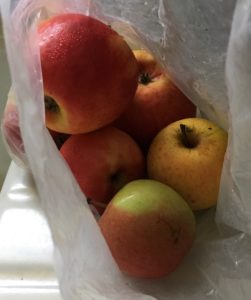
In the United States, a lot of our food comes from thousands of miles away. Instead of having to eat in season (or should I say getting to eat in season, since local produce in season is so tasty), we’ve become used to being able to get any kind of produce year-round: pears from Chile; strawberries from Argentina; spinach from across the country.
A great way to reduce your eco-footprint is to get as much of your diet from locally grown/raised sources as possible. I grow a bit of my own greens and herbs, and also buy from local farmers at our weekly farmer’s market.
Still, I like to treat myself to something exotic sometimes. Here in Florida, apples are exotic. They usually come from Wisconsin or New Hampshire … or, when it’s summertime in the northern hemisphere, they come from South America or New Zealand. I don’t buy apples at the supermarket except on rare occasions.
But in wintertime, we get a treat at our farmer’s market, because one of the vendors is a guy who has an orchard up in Wisconsin. He comes down here every winter to sell his wares. Since he stays for the winter and he’d be coming here anyway, I don’t feel like I’m adding food miles to my eco-footprint.
It’s great to pick out a mixed bag of richly flavorful apples for $1.25 a pound: Jonagold, Fuji, Yellow Delicious and Red Delicious (which are so much sweeter than the ones sold at supermarkets), and many other varieties. The bag of apples pictured here was my exotic treat for today’s shopping trip!
Of course, now delicious grapefruits and other citrus are coming into season, so we have an abundance of produce from right here in Florida too.
Apples are exotic here in Florida, and it would be out of the question to try to grow them here. At least that’s what I always thought! Just now, out of curiosity, I googled “Can apples grow in Florida” and sure enough, the UF-IFAS site is Johnny on the spot (or should I say Jonagold on the spot!), offering a list of apple varieties that can be persuaded to grow in parts of central and north Florida. To produce fruit, the trees need 300 to 400 hours below 45F during the winter.
